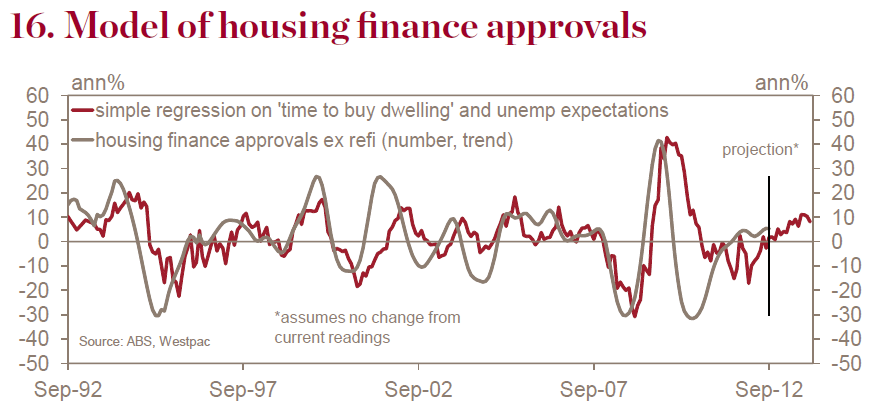The Westpac Red Book for October is out and paints a picture of housing market sentiment turning strongly upwards:
- One of the highlights in last month’s survey was a big 9.6% jump in the sub-index tracking views on ‘time to buy a dwelling’ to the highest level since Sep 2009, and prior to the 2009 recovery, since Dec 2001. That positive move was cemented in Nov with the sub-index sustaining its high level despite the RBA’s surprise decision to leave interest rates unchanged.
- This supports the view that the level of interest rates has now reached a point that is generating a stronger recovery in housing activity. Although we have yet to get confirmation from finance approvals (data is only up to Sep), auction activity showed a clear firming in Oct-Nov.
- Prospects for a housing recovery have also received a big boost from the improvement in unemployment expectations (see p15). Job loss fears are a key factor in the house purchase decision with elevated fears clearly restraining the recovery to date.
- Our simple model of housing fi nance approvals – based on responses on ‘time to buy a dwelling’ and unemployment expectations – was pointing last month to a modest recovery of around 5% by mid to late 2013. With no change in ‘time to buy a dwelling’ but an improvement on unemployment expectations the same model in Nov now points to a 10% gain.


If this is right, then all things being equal, 10% annualised housing finance approvals growth will be enough to generate significant property price growth. So am I convinced? No.
Why? First, things are no longer equal. We are in unprecedented times. Deleveraging will continue for many so I expect that will significantly offset any acceleration in mortgage approvals and I’m unconvinced that Westpac’s model captures this.
Second, I am also skeptical that unemployment expectations have peaked. It may be that the vast majority of folk reckon the era we’ve lived through was difficult only because of the mining boom, and its passing is a blessing, but that is an illusion. Underneath that the real structural problem in the economy is too much private debt, a fundamental lack of competitiveness and a ratings bound national budget. As the mining boom ends, growth is going to slide, and authorities do not have the wriggle room to simply turn back to a borrow and consume growth model.
If folks all weigh back into established houses, interest rates will rise earlier in the cycle than they used to, the dollar will remain way too high for our productive economy, and growth will be choked very quickly.
Unemployment is not done with us yet.

